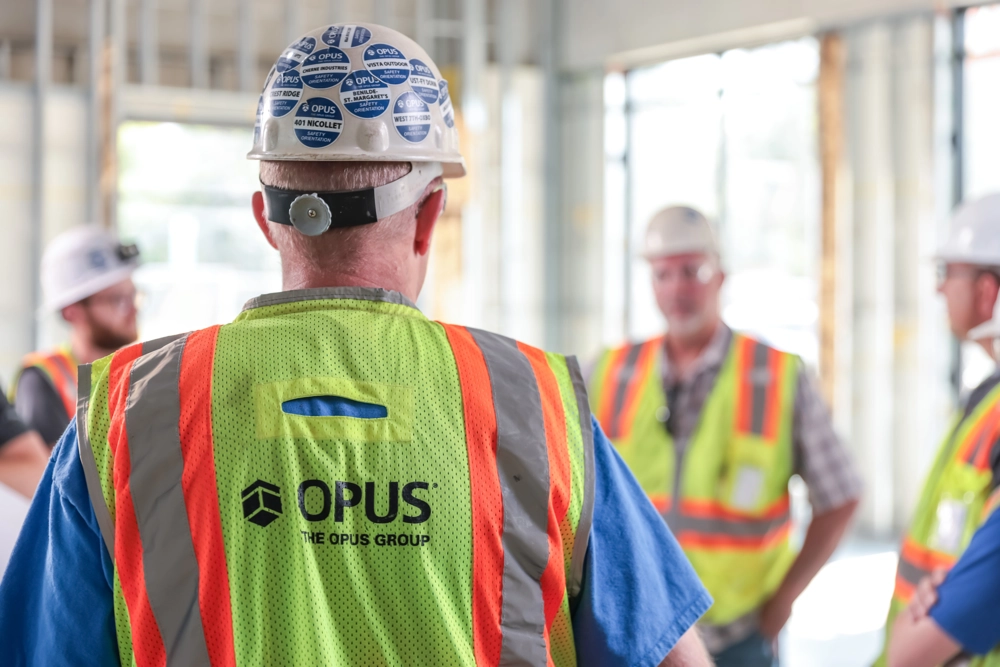Cultivating Our Culture of Safety
Prioritizing safety goes back more than 70 years, when Gerry Rauenhorst started a construction business that would evolve into The Opus Group of today.

In 2019, just months after being promoted to Director of Safety Management, we interviewed Josh Babiasz about our in-house safety team and mission. Now, five years later, we reconnected with Josh to see if and how the team's efforts have evolved. According to Josh, one overarching theme that was present then and is even more prominent today is our culture of safety.
We use the phrase safety culture frequently to convey that we believe protecting people, work environments and communities is a priority and that we behave accordingly. This phrase is actually widely used throughout the construction industry, but how a safety culture is cultivated and sustained is specific to each organization. With Josh's guidance, our safety culture is now firmly grounded in strong leadership, employee cooperation, clearly defined practices and expectations, as well as a commitment to continuous improvement.
Safety-Minded Leadership
Prioritizing safety goes back more than 70 years, when Gerry Rauenhorst started a construction business that would evolve into The Opus Group of today.
“Gerry was a family-first kind of guy, and not just his family, but everyone's families," said Josh. “His priority was to make sure every employee made it home to their family at the end of the day. He had a lot of integrity and respect for his employees, and his employees knew that… they felt it. And I think that's how you start building a culture of safety, because no one can argue with wanting to get home to their family."
But Josh notes that it wasn't until the early 1990s, during his predecessor's tenure, that the organization really put a stake in the ground by adding safety to our list of core values. Since then, Opus has developed a leadership team across the organization that shares Gerry's values of integrity, respect and empathy and that understands a safety culture is more than words or actions, it's a defining legacy.
“Safety cannot be one person's responsibility. I may hold the job title, but my success is completely dependent on collaboration with our leadership," said Josh. “I am very fortunate, the entire organization is very fortunate, that we have leaders who are guided by many of the same values as Gerry. In order to value safety you must first value other people, and our leaders do."
Personal Accountability
A safety culture can't exist without associate buy-in. Simply put, associates must be willing to take personal responsibility for their actions or inactions.
“This is tough," said Josh. “Safety isn't something we can just mandate or force on associates. We can't make them value safety. But you bet we can keep safety front and center so they know full well that we prioritize it."
To that end, Josh makes it a point to openly talk about safety every single day – not just behind closed doors, but in his job-site conversations with project managers and subcontractors and in his informal conversations with colleagues. He also includes associates in developing safety strategies and encourages them to share input into what's working in the field and what isn't.
Said Josh, “My hope is that by making safety part of my daily conversations, I help instill in associates a desire to prioritize it. You can never underestimate the power of personal accountability, and this goes for our office associates, our field associates and even our subcontractors. When every individual prioritizes safety, we not only see fewer injuries and fatalities, but we see improved morale, better teamwork and fewer project delays."
Shared Knowledge
Josh recognizes that in order for everyone in the organization to embrace and advance our safety culture, he bears responsibility for ensuring safety practices and expectations are clearly defined and communicated.
“There's that saying that you don't know what you don't know. So safety can't be a secret," said Josh. “This is especially important as we make changes to our practices to keep up with new regulations, in response to a near-miss, or because of organizational or operational changes, like when we stopped self-performing."
Newer safety practices Josh has instituted in the last five years include hiring third-party safety consultants for each job site and organizing field supervisor safety committees. Josh has also initiated a safety email Q&A in which associates send him safety related questions, and he shares his answers broadly as a way to reinforce best practices. The biggest change in the last five years, however, relates to training, which is now conducted almost exclusively online. The switch to online and video training has allowed Josh to leverage AI to create realistic simulations, to develop short topic-specific training sessions, and to enable associates to re-watch a training video as often as needed.
As for our safety expectations of both our associates and with our subcontractors, Josh quickly exclaimed, “That hasn't changed. Our expectations remain safety first, safety first, and safety first! To truly live our safety culture, to be true to our very DNA and to ensure every associate and job site team member goes home to their family at the end of the day, we must, every one of us, put safety first."
Never Good Enough
The probability of any company perfecting job-site safety, achieving zero incidents and attaining 100% compliance every minute of every day is challenging given that construction is inherently dangerous and the irrefutable fact that accidents, resulting from human or mechanical error or even unpredictable weather patterns can and do just happen, despite any and all prevention efforts.
“We will never look at our safety record, our awards or our successes and say that's good enough. Good enough is never good enough when it comes to safety. We can always do better, and we will always strive to do better. I think I can confidently speak for our leadership when I say that, and I believe I can speak for our associates and our subcontractors, too," said Josh.
He added, “In many ways, safety and, in particular, a safety culture is like a living and breathing thing. To thrive, it needs care and attention. It needs to be nurtured and appreciated. It needs to be recognized, actualized. As long as we do these things and as long as we continue to strive to be better today than we were yesterday, we are building on Gerry's legacy."
Article Type: Blog Post
Topics: Safety


